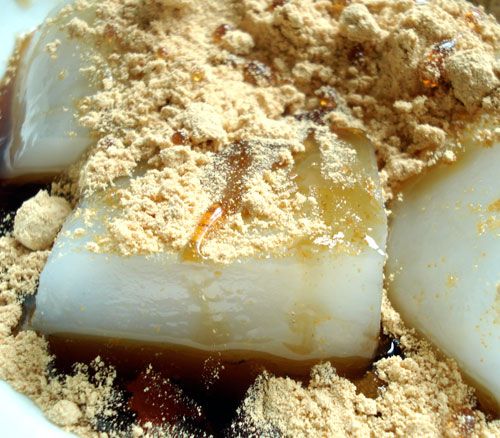
I wrote about the use of kuzu powder in the _goma dofu_ (sesame tofu) recipe. This time it's a very traditional, simple sweet dish using kuzu.
Kuzumochi are sticky 'mochi' cakes made with just kuzu powder, sugar and water. The texture is somewhere in between gelatin and mochi made from rice flour - wobbly but not too sticky. It's traditionally served chilled, so it makes an interesting, gluten free (and vegan) summer dessert.
Filed under:
dessert japanese sweet summer vegan gluten-free wagashi
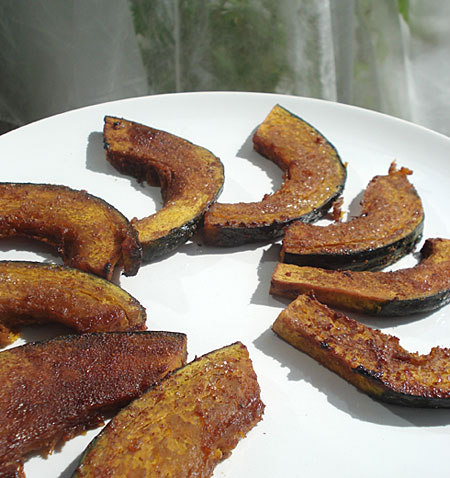
I hesitated to put this recipe up, because it's not the prettiest thing in the world. But it's so tasty, dead easy to make, and of this season - so, here it is. As a bonus it's full of fibre and is relatively low-calorie, low-sugar etc for people who want a bit of something sweet without going on a massive guilt trip.
Most recipes out there for using winter squash seem to involve pureeing them, but I rather like them when they are in chunks or slices. This roasted squash has a sweet, spicy and salty glaze of sorts on them, which brings out the dense sweetness of the fruit. Cut into fairly thin slices like this, it makes interesting finger food. You can vary the sugar and spice to your taste, though too much of either may overwhelm it.
You do need to use kabocha-type squash for this ideally, though butternut should work too. You will need a dense, starchy and sweet squash. Don't use regular pumpkin, which is too watery and lacks sweetness. (Rouge d'etampes pumpkin may work, but I've found their sweetness to vary quite a bit.)
Filed under:
japanese fall vegetarian sweet vegan
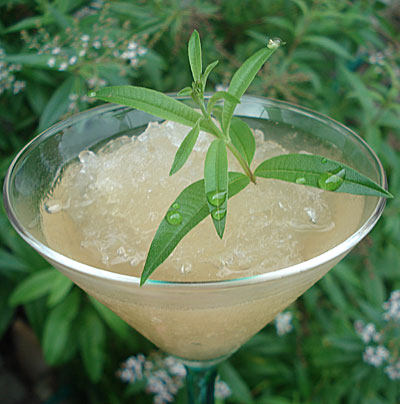
The lemon verbena plant that I planted last year and almost lost to a summer storm, is now firmly established and positively thriving. Whenever I pass it I can't resist rubbing a leaf, because it smells so wonderful.
Transferring that wonderful lemony scent to taste is quite easy - simply steeping it in some boiling water for about 10 to 15 minutes does the trick. This granita is infused with the aroma of lemon verbena, soured with a little lemon juice, and sweetened with a delicate acacia honey. Any light colored honey will work here instead. It makes a wonderful light dessert or palate cleanser, or cooling summer snack.
Filed under:
dessert lighter vegetarian sweet summer tea
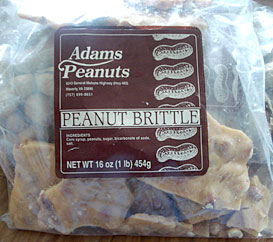
One of the (many) food obsessions I have is nut brittles. Peanut brittle, macademia nut brittle, almond brittle (which, when pulverized, turns into praline). I love that combination of caramel and nut flavor. Peanut brittle is the most handy kind to get a hold of, and make. I make it as often as my teeth and waistline allow.
But, I realized yesterday that I have never had truly good peanut brittle.
Filed under:
snack sweet shopping favorites
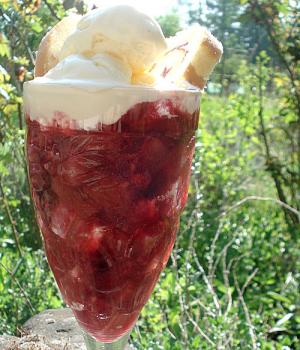
On rhubarb, stewed fruit and England
I first saw this curious plant called rhubarb during the time we lived for 5 years in Berkshire, England. I was 5 when we moved there. The rhubarb grew like a small jungle in a corner of the vegetable patch of the house we were renting, alongside some equally puzzling gooseberry bushes. Neither existed at all in Japan at the time, and my mother was at a loss as to what to do with them, until our next door neighbor lady told her how to stew them. The neighbor lady believed in stewing most fruit - she told my mother to stew or jam all of the raspberries too, since eating them raw may lead to upset small tummies. Thankfully my mother didn't take her advice for all of the raspberries, and I still have memories of stickily enjoying bowls and bowls of red, ripe raspberries with clouds of whipped cream. One of the first things I did when I got my own garden was to plant several raspberry canes.
Stewed and cooked fruit figures quite prominently in my memories of English food at the time. This was in the '70s. Whenever I was invited to tea at a friend's house, there was usually always some sort of cooked fruit dish, be it a compote of peaches in the summer or apple and blackberry pie later on in the year. I think we only ate fresh, raw fruit at home, except for bananas and strawberries. I didn't even know that gooseberries could be anything other than sour, green and only edible stewed with sugar, until I came to Switzerland and saw them left to ripen on a bush, turning a bright reddish-purple.
That penchant for cooking fruit does mean that there are many terrific fruity desserts (aka puddings) in British cookbooks. One of them is trifle. I'm in the midst of my annual rhubarb orgy period, and it's one 'fruit' (though it's botanically a vegetable) that needs to be cooked. Hence, the rhubarb trifle.
The slightly modernized trifle
A trifle is small pieces of sponge cake soaked in a sweet, fruity liquid, and topped with custard or cream. Some versions of trifle are quite alcoholic, but this one has no alcohol in it since I imagine my 8 year old self tucking into it. The components are simple: the fruit-liquidy mix, the cake, and the creamy topping. The key part that makes this trifle different is the rhubarb soaking liquid part, which is quite sour and not too sweet. I've added a few frozen berries (raspberries from last summer's crop in fact) to make the red color more intense - if you have fresh strawberries by all means use those instead.
Trifle is traditionally topped with custard, cream or both. Here I have combined the two so to speak and topped it with vanilla ice cream instead - this is the slightly modernized part. It's homemade but you can use a good store bought ice cream if you don't want to bother, or don't have an ice cream maker.
I think that the key to a good trifle is to not overload it with sponge cake, which makes it go rather stodgy. Add just a few pieces for the interesting texture. Note that I've used pieces of store bought roll cake here (called Swiss roll in England, but not really Swiss as far as I know) which adds some extra flavor. You can assemble it all in a big bowl, or in individual glasses as I've done here.
This is my pre-planned entry for Sam's Fish and Quips event celebrating British food. See also my other two British-theme posts this week, Tasting Guinness Marmite and The Edwardians and their food.
Filed under:
dessert fruit rhubarb spring sweet uk
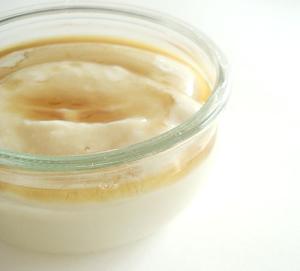
One of the things I like to do with tofu that didn't quite come together is to turn it into a pudding. Now I do not pretend to you that this tastes like a proper pudding or mousse made with cream and such, and if anyone tries to convince you that a tofu based dish like this is 'just as good/rich as the real thing' they are either lying or have no taste buds. It's different, but still good. It's a lightly sweet, cool and creamy dish that will quiet a sudden urge for Something Sweet. Since it's quite healthy it will leave you feeling righteous, thus the name.
It's also a dish that you can whip up in no time at all. I realize that many of the recipes here take a lot of time, effort or both, and I'm going to try to rectify that. Look for recipes with the quickcook or under 10 tags.
Filed under:
dessert lighter vegetarian sweet tofu quickcook vegan under10
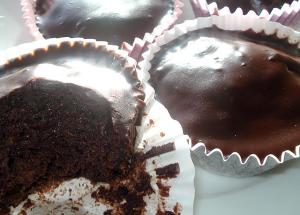
In the movie Chocolat, Juliette Binoche plays a somewhat mysterious woman who opens a chocolate shop in a small French village. She uses ancient Aztec spices in her chocolate confectioneries, which soon prove to have almost magical, often aphrodesiac, properties. While Chocolat is not in my top 5, or even 10, favorite food-theme movies (see here for that list), the idea of spiced chocolates has intrigued me ever since I saw it. One of my favorite chocolate bars is the Masala one made by Dolfin.
Making a spicy chocolate confection is a bit of a tricky affair though. You don't want the spices to overwhelm the chocolate - it should just form a sort of interesting background, yet provide a bit of a surprising bite and a warm, 'what is that?' quality.
These cupcakes have a rich but not too sweet bisquit (cake) base, with the warmth of curry powder and the bite of coarsely ground pepper. They are moistened with a teaspoon per cupcake of mocca liqueur, which increases its intensity and pushes it into the realm of an adult indulgence. The chocolate ganache has a pinch of cayenne pepper in it. The marriage is quite successful (or so the Tasters emphatically agreed). I'm not sure if they work at aphrodesiacs, but if your sweetheart is a chocoholic, you never know... They make a terrific Valentine's Day dessert or treat in any case.
Filed under:
chocolate dessert baking sweet cake cupcakes valentine
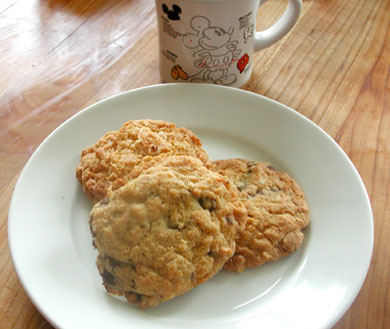
The usual image of homebaked chocolate chip cookies, at least in the U.S., is that of large, thick cookies with a soft, rather gooey center. The soft and gooey texture is so desired by many people that commercial cookie manufacturers even manage to maintain that in cookies that have been on the shelf for months. This to me seems very wrong. And, I don't think that gooey-soft necessarily indicates a good quality chocolate chip cookie either.
Sure, when you take the cookies out of the oven and eat them right away, they are sort of gooey and soft. But once they cool down, I prefer them to be rather crispy, even lacy, and delicate. For this reason I add a bit more butter than is normal in the traditional Toll House type of chocolate chip cookie. This makes the dough spread out more during baking, making the cookies thinner. Using slivered almonds instead of chunky nuts also makes them lighter and crispier.
If you prefer the gooey type of cookie though, use more flour or less butter.
I also use raw (light brown) granulated sugar instead of the fluffy dense brown sugar used in the traditional recipe. This is mainly because we can't get that "packed" sort of soft brown sugar here. Also, the dark brown sugar has a very pronounced molasses-like taste to me, which I don't think really fits for this cookie.
These are very adult chocolate chip cookies, because of the almonds and the dark chocolate chips. Of course kids love them also. I made these with the lemon bars in the preceeding recipe and meringue kisses for Easter, and boy were they popular.
Filed under:
chocolate party food snack baking cookies sweet nuts
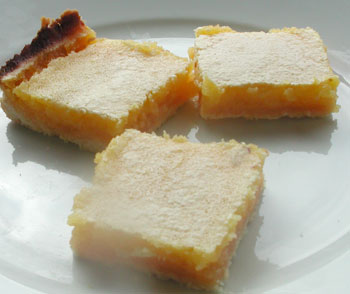
A while back I posted a recipe for lemon squares, a sort of cross between a cookie and a tart with a lemon-curd topping. Some people tried it out, and found it a bit too tart. I went back and fiddled around with the proportions of sweet to sour (lemon juice), and here is the result. There is more curd, which I think makes it even better. The curd is quite a bit sweeter with 1 cup of sugar, and the extra egg makes it creamier also.
Filed under:
dessert snack baking cookies sweet lemon
Pages